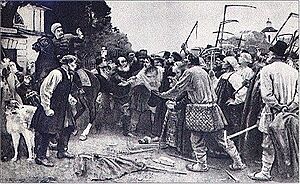Potato riots facts for kids
The "Potato Riots" were big protests in the Russian Empire. These events happened in 1834 and again from 1840 to 1844. They involved many peasants who were unhappy about being forced to grow potatoes. These peasants included udelnye krestyane (imperial peasants) and state peasants. Imperial peasants lived on lands owned by the Russian royal family. State peasants lived on lands owned by the government.
Contents
Why the Potato Riots Happened
The main reason for the riots was the government's decision to make peasants grow potatoes.
Forced Potato Planting
The government wanted more potatoes grown across the country. They chose the best farming land for these potato crops. Peasants were told they had to plant potatoes, even if they didn't want to.
Harsh Rules and Punishments
If peasants did not follow these new rules, they faced tough punishments. The authorities were very strict. They also made peasants pay extra taxes or give up goods. This made many people very angry and frustrated.
Where and When the Riots Took Place
The first signs of trouble appeared in 1834.
Early Protests in 1834
Unrest began in areas like Vyatsky and Vladimir provinces. These early protests showed how unhappy people were.
Major Riots from 1840 to 1844
The biggest riots happened among state peasants between 1840 and 1844. These protests spread across many regions at the same time. They were also partly a reaction to new rules for state villages. These rules were introduced by a man named Pavel Kiselyov from 1837 to 1841.
Regions Affected
More than 500,000 peasants took part in the riots. They were mostly in the Ural region and near the lower Volga Region. People destroyed potato fields and sometimes attacked officials. They also chose their own leaders, ignoring the government's choices. When soldiers came to stop them, the peasants fought back with weapons.
Different Groups Involved
It wasn't just ethnic Russians who joined the riots. People from other groups also took part. These included the Mari, Chuvash, Udmurt, Tatars, and Komi people.
Beliefs and Consequences
Some old stories and beliefs also made the riots bigger.
Rumors and Fears
There were rumors that planting potatoes was linked to evil. Some people believed it was a way of serving the "Antichrist." These fears made many peasants even more determined to resist.
Government Response
The government sent soldiers to stop the riots. In some places, soldiers shot at the peasants. Thousands of people who rebelled were arrested. Many were sent far away to Siberia. Others were forced to become soldiers.


